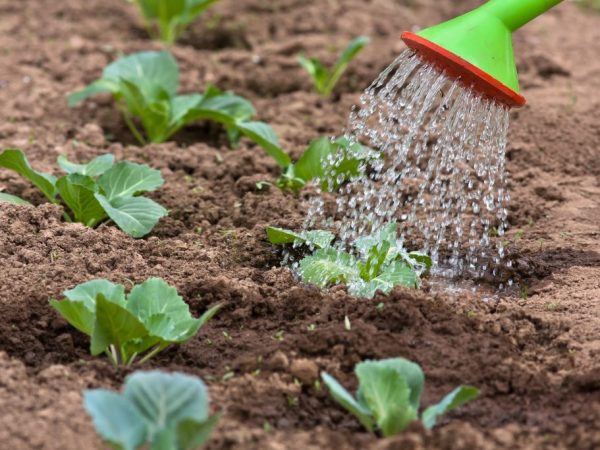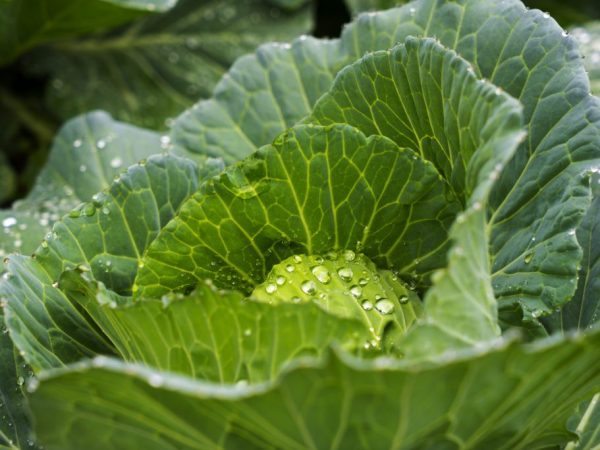Watering cabbage in the open field
Cabbage is not easy to grow. For a good harvest, proper care must be taken. One of the most important actions is cabbage watering, which directly affects the taste of the plant. Consider how often to water the cabbage.

Watering cabbage in the open field
How to identify a lack of moisture
The main criterion for a lack of water is the appearance of the fetus. Most often it is the poor condition of the leaves. This can be caused by the rapid evaporation of moisture from the sun, which causes a lack of moisture for the roots.
The condition of the soil can also indicate a lack of fluid. The soil is rolled into a ball, and if it crumbles or cracks when pressed, the frequency of irrigation is increased.
Water for irrigation
When growing any variety, it is necessary to take care of the good quality of the waters used. The main criterion that affects the growth of a vegetable is temperature. It is necessary to water the cabbage with water of the required temperature, starting from the first stages. Irrigation of crops with cold water negatively affects the development of roots. The result is a complete stop of tying the forks, various diseases and the complete death of the vegetable. In the open field, cabbage tolerates watering with cold water especially poorly.
Watering directly from the tap, well or well is not recommended. It is enough to collect water in a container and let it warm up to room temperature. For faster heating of water, you can use a black container. It is better to water the plant outdoors at temperatures around 20-23 ° C.
Watering cabbage
The need for watering the vegetable increases with the development of the plant. There are several methods for watering cabbage outdoors, depending on the variety.
Most often, you need to water the cabbage with water after planting the seedlings in the ground and after the head of cabbage has begun to form. During these periods, watering the vegetable is necessary several times a day for a couple of weeks. During sheet formation, the frequency of moisture application is reduced.
What does watering depend on
The frequency and intensity of watering depend on a number of factors:
- Features of the variety. Some species may be more demanding on moisture, while others are vice versa. In this case, humidification is performed based on the requirements of the variety for moisture.
- Weather and climate. The amount of water is determined based on the presence and frequency of precipitation, drought severity and air temperature. In hot regions, cabbage requires moisture more often. This also includes the stage of development of the fetus.
- Moisture addition if necessary. This is an economical method in which irrigation is performed in the morning or evening. Water is poured into the pits around the roots. With the strongest need for the fruit in water, use about 30 liters per 1 k.in m. During the period of drought, watering is increased to 45-50 liters.
After any of the selected irrigation methods, hilling must be carried out. For early varieties of cabbage, it is carried out 2-3 times, and later 3-4 operations are necessary. The seedlings then strengthen their roots.Hilling is necessary only for wet soil.
Recommendations
Gentle irrigation can be carried out to prevent the appearance of various diseases and pests. For this, you can use special solutions. Popular remedies are leaf decoctions and vinegar solutions. To achieve a therapeutic effect, the liquid must remain on the plant for some time, and it can be accidentally washed off with water.
For cabbage, irregular watering during an important period can be fatal. Irrigating too often can also be harmful. Abundant watering after a drought often leads to cracks in the head of cabbage.
Watering methods

Sprinkling will provide air humidity
There are 3 of the most popular and effective ways to water cabbage outdoors:
- Watering the cabbage along the furrows with a hose. The method is applicable only for mature plants, a large amount of water can damage the vegetable at an early stage.
- Drip irrigation. In this case, water is supplied to the plant in small portions, which provide a sufficient amount of moisture during active growth. The disadvantage is the high cost of equipment, as well as the possibility of waterlogging of the soil by the drip method.
- Sprinkling method. Provides moisture not only for the soil, but also for the air. Irrigation is carried out by special installations. Together with water, the culture can be treated with top dressing and various medicinal preparations. The disadvantage is the possibility of waterlogging in the ground.
When to water
After planting in the ground, the seedlings are watered every 3-4 days at 8-10 liters per 1 sq. m. In the future, the volume will be increased to 12-14 liters.
The early varieties will require more moisture in June, while the later ones will require more moisture in August, when the head of cabbage begins to form. Water is brought in in the morning or in the evening. In the dry season, the amount of moisture doubles. Drip irrigation at such a time is most effective, since it gives a constant flow of moisture into the soil. In the absence of special installations, water can be dispensed with a watering can.
The need for irrigation depends on the climate. Most often it is necessary to carry out it in an area where the liquid quickly evaporates from the soil.
It is necessary to completely complete the application of moisture in the fall, a few weeks before the start of harvest. This is done to increase the shelf life of the vegetable after cutting and to eliminate the possibility of cracks in the heads of cabbage.
Top dressing after watering
It is necessary to carry out top dressing during the entire period of growth of the vegetable, immediately after abundant watering.
The first
The first feeding is carried out 2 weeks after planting. During this period, a solution of mullein (5 parts of water and 1 part of fertilizer) or bird droppings (10 parts of water and 1 droppings) in a volume of 1.5 liters per plant is introduced into the soil. An alternative is ammonium nitrate solution.
The second
The second feeding is carried out when the leaves began to actively develop. This is 15-20 days after the first feeding. In this case, superphosphate, nitrate and potassium sulfate are used in a ratio of 2: 2: 1. You should add 50-60 g per 1 sq. m. Application of mineral fertilizers will be useful.
Third
The third feeding is carried out if necessary (in the presence of a disease or slow development). It should be carried out no earlier than 14 days after the second, before that it is important to thoroughly water the beds. It is customary to use a mixture of potassium sulfate and superphosphate in a ratio of 1 to 2. One plant consumes 25 g. Wood ash is added to chemical fertilizers.
Application rules
It is necessary to apply fertilizers so that they do not fall on the leaves: this causes burns. You need to pour top dressing under each fruit, observing the dosage. After top dressing, it is important to loosen the soil between the rows. If there is a need for long-term storage of the fetus, more potassium should be added to the dressings.
Conclusion
How to water cabbage correctly, every gardener should know. With frequent watering, you can achieve the formation of full-fledged heads of cabbage, even in dry climates. Irrigation is only one part of a large and laborious process.If you supplement it with proper plant care, you can count on a good harvest.


